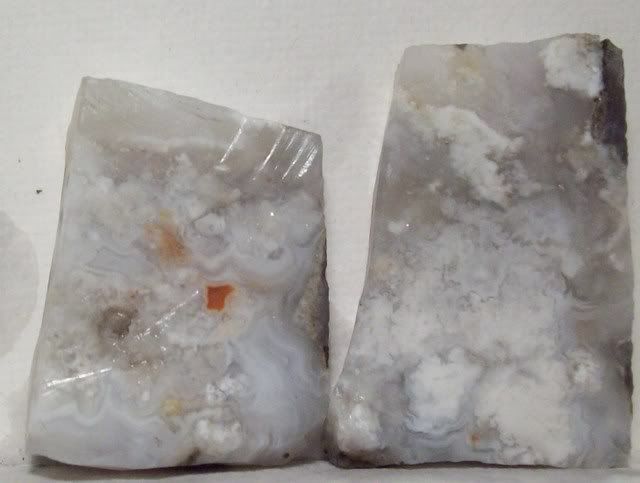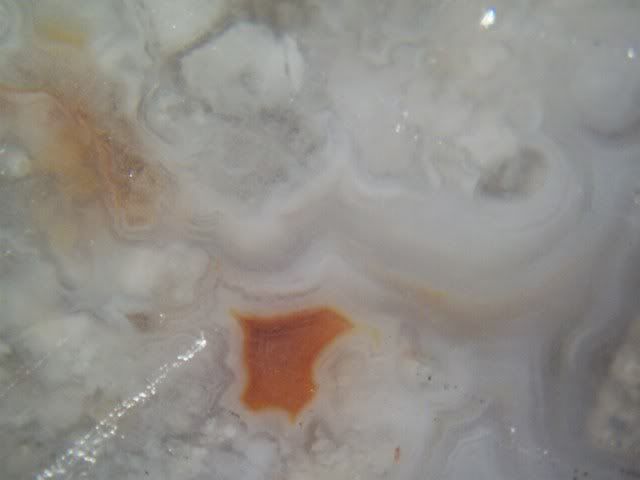|
|
Post by sitnwrap on Dec 31, 2008 13:03:11 GMT -5
I found a rock and cut it this past spring when I first became a member. I went looking for it recently because my knowledge has expanded and I remembered this as an unusual rock for MA.  other side  close ups with a loupe where delicate bandings have formed  As I gather knowledge, more questions come to mind. Why doesn’t Massachusetts have an abundance of agate and since MA has a lot of Quartz, and since I found this and it looks like agate, can Quartz morph into agate? So I googled “how does Agate form” and I found the site. www.rps.psu.edu/0109/form.htmlIt is really cool reading and my logic was basically correct. Though I don’t understand a lot of it, what I read will be tucked away for future use. I put this in the specimen forum because those who are very interested in specimens are apt to be interested in the how and why of formation also. I thoroughly enjoyed the article and I hope you do also. Thanks for looking and reading. Lori |
|
|
|
Post by Woodyrock on Dec 31, 2008 14:33:23 GMT -5
Lori:
Most people tend more to the gel theroy than they do this treory. The SiO 2 gel (Sol Gel) is one of the fastest moving research areas today. Silica gels can be catalyzed thus forming a crystalline structure. This technology is cutting edge stuff in the coatigs industry today. Do a google search on solgel for more information.
On the Massachusetts thing, one does not find agate in granite, and the Bay State is mostly granite.
Woody
|
|
DeanW
has rocks in the head
  
Member since December 2007
Posts: 721
|
Post by DeanW on Dec 31, 2008 15:18:52 GMT -5
On the last "Fringe" that Karen and I watched, a terrorist went onto a public bus, dropped a canister that smoked out like a tear gas or smoke bomb. Ended up, if I heard correctly, that the smoke/mist solidified and turned into a silica gel suffocating all those onboard. |
|
|
|
Post by sitnwrap on Dec 31, 2008 15:54:04 GMT -5
Thanks Woody for the info and I will google it. Boy o boy am I aware of how abundant granite is in this state. But there is also a fair amount of quartz and that is why I had questioned what I cut into. Just this past summer, my boys found a huge quartz or maybe quartzite boulder (has to be a 30 or 50 lber) in the woods and brought it home to me.  will probably post a pic of that when the snow goes away. Dean, I think that anything that scientists figure out how to create in order understand how and why things happen can and will be exploited by others for horrible purposes . It is a terrible thing what humans do to each other and it's also a sad scenerio because as people in general our attention tends to be grabbed strongest by the negative of things rather than the positive. I bet many more have heard of this because of that attack rather than because of the breakthrough of understanding how agate is formed. It's just my opinion though. |
|
|
|
Post by frane on Dec 31, 2008 18:46:05 GMT -5
That is a beautiful specimen! I am always curious on the why and hows as far as rocks go. No matter the rules, sometimes the rocks just don't follow them as we see with that one you have.
Thank you for the information all.
Fran
|
|
theimage1
starting to shine!

Member since August 2008
Posts: 33
|
Post by theimage1 on Dec 31, 2008 21:47:54 GMT -5
Currently the general theory of agate growth revolves around two requirements. Remember agate is micro-crystalline. (cryptocrystalline)
1.) A place to grow (either a hollow area in a rock or a vein). Typically they grow in the bubbles that are formed when basalt degasses as it cools. But they are also found in Rhyolites and Andesites as well as the more rare limestones. The limestone process is usually somewhat different than the others.
2.) Second requirement is a source of the needed silica. This often comes from a silica rich magma like rhyolite or andesite. A volcanic area may have both types of lava during its active phase. A primary system for agate growth would include an early basalt flow forming a rock with many voids (bubbles and or cracks). Followed by a more explosive rhyolite ash-flow that covers the basalt. The rhyolite is then weathered by rain/water and CO2 from the air which produces a weak acid that can dissolve the silica from the rhyolite. The resultant solution builds up in the open voids of the basalt. (There are numerous theories from here as to how the agate actually forms.) Some include solution, and some include a gel. The molten theory to agate growth is not held in high regard at this time.
Terry Moxon (UK) and Roger Pabain (Nebraska) have both written books on the topic.
The other agate formation appears to happen in limestone with the silica from diatoms or other skeletal remains supplying the needed silica. Agate has not been found in granite, but keep in mind that granite is roughly the same chemistry as rhyolite/andesite. The difference is that granite crystallizes at depth and the excess silica actually crystallizes as quartz or gets tied up in feldspars and other minerals. It cools slowly because it is buried and not able to release heat quickly. Thus large crystals.
Rhyolites and andesite cool rapidly as they are extrusive forms of magma that come out into the atmosphere. Thus they cool quickly forming smaller crystal size materials. Rhyolite that cools really quickly turns to obsidian. (Which again has roughly the exact same chemistry but no crystallinity.) Their smaller crystal size, their lower density, and higher porosity makes them more susceptible to weathering.
Most of new england has no remaining volcanic structures. It is the base material from an ancient range of mountains that has been uplifted and worn away. It is very much older rock that formed at depth. Hence not an ideal area for agate creation even though there is abundant quartz.
|
|
|
|
Post by sitnwrap on Jan 1, 2009 14:55:31 GMT -5
Thanks for all this information and much of it I understood (I think). This was a beach rock found on an open shoreline so what ever it is and where ever it came from, I'm glad I posted it cause otherwise, I would not have gathered all this great information that everyone posted.
|
|
navi
starting to spend too much on rocks
 
Member since November 2008
Posts: 229
|
Post by navi on Jan 3, 2009 10:50:35 GMT -5
i hope to finally be able to post photos soon. i recently found a rock that i'll post. it is banded amethist agate/onyx and shows many growth layers. you can see the bands and in areas on the top surface, some layers are peeled off, showing the layer underneath and so on. you can see how it was formed, a layer at a time.
|
|
fanatic
starting to spend too much on rocks
 
Member since October 2007
Posts: 233
|
Post by fanatic on Jan 3, 2009 14:24:47 GMT -5
This has been a great thread so far! I have to read it several times before it sinks in, but I'm learning a lot. thanx for getting it started Lori.
I live in the Finger Lakes region of NY and haven't really collected specific specimens locally. However, being a gold prospector I keep my eyes peeled for any quartz. I have collected a few larger rocks fist sized and up that are quite interesting in that they are laced with small garnets. Some appear to be a granite and some are more of a sedimentary rock. if I ever learn to take pics I'll show them off.
One of the places we pan is a slate gully that feeds Keuka Lake. The gully was mined for the slate in the late 1800's. We find gold, garnets, magnetite, hematite and some really light colored quartz. The Finger Lakes were formed by glaciers and thats where those materials came from. We found glacial drift areas above the gully that are so tightly compacted you can barely chip them with a pick. One particular granite boulder in that gully is completely smoothed and at least 4 feet in diameter. its one of things that when you see it makes you ask "How in the heck did that ever get in this solid slate gully?"
Gold in NY? That fanatic is just a crazy old man. Theres no gold in NY! hehehe
Question for the better informed - could some of the reason we don't find the agates here be related to the age of our mountains? The Rockies are just infants compared to the Adirondacks.
Lori - I never noticed you were from the east coast until this thread.
|
|
|
|
Post by sitnwrap on Jan 3, 2009 15:06:51 GMT -5
Yup, born and raised. There is a post someone started showing what can be found in each state and some specific mines. I got real excited because it lists Agate being found in Plymouth County, specifically Middleboro which is close to where I live. www.missourigeologists.org/Min-Loc2-2005.pdfI also couldn't believe the variety of rock that can be found here. Gives me new hope for future hounding in my own back yard. I got a small stream right out back and been itching to pan it. hehe |
|
fanatic
starting to spend too much on rocks
 
Member since October 2007
Posts: 233
|
Post by fanatic on Jan 4, 2009 10:24:43 GMT -5
I have a small stream running through my property as well. Mudlick Creek. Thats where I got my business name - Mudlick Creek Jewelry Co.
I've panned in it and nothing so far. All busted slate. The "bedrock" is bed clay on my property. Downstream 5 miles I found a hard packed gravel bank that appears to be an ancient tertiary river flow. Found it while "binocular prospecting". I also found a similar area using the same method about two miles north on the creek that the Mudlick flows into only this bank has clear bands of the hardpack. I'll be seeking permission when it thaws and I'll be keeping my eyes peeled for more than just gold.
|
|